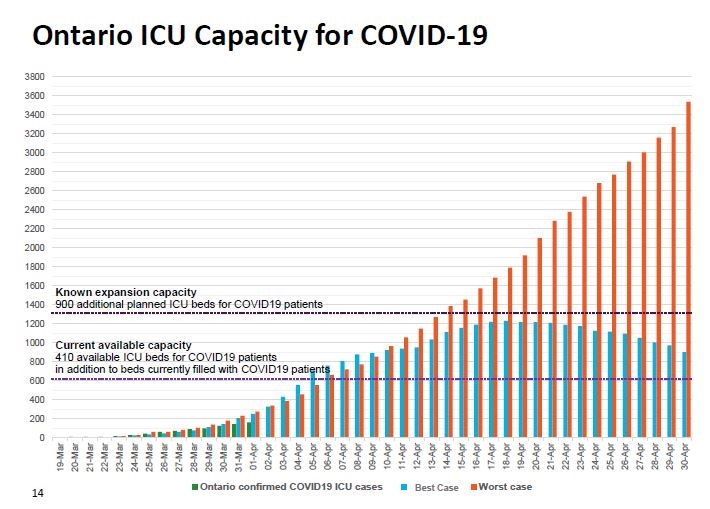Ontario government has revealed projection numbers for the province to be just under 1,600 COVID-19 deaths and 80,000 cases by the end of April, if the current measures in place are upheld.

President and CEO of Public Health Ontario Dr. Peter Donnelly alongside President and CEO of Ontario Health Matthew Anderson and Dean of the Dalla Lana School of Public Health Adalsteinn Brown revealed the projected numbers at Queen’s Park on Friday.
The data also indicated that Ontario would have seen 300,000 cases of COVID-19 and 6,000 deaths by the end of the month if there was no government action or intervention.
“We are following a trajectory somewhat similar to that in the United States, not quite as good currently, as that in British Columbia,” Donnelly said.
“But I would hastened to say that when one tracks cases, it really is rather difficult to know exactly where you stand, you have to watch it extremely carefully, because it is rather dependent upon who you test for the disease.”
“Over the full two-year course of the pandemic, had we done nothing, Ontario may have suffered 100,000 deaths,” Donnelly added.
“Thankfully that is not the position that we are in. Because of the very detailed actions… which have been taken in response to the emerging science, we believe that if we can do all that we can, we can get a much better end result for the province.”

Get weekly health news
“We must take these warnings seriously,” Premier Doug Ford said. “We must recognize that the numbers also show that everything we’ve done so far, everything we’ve done together since this started is working.”
“Thanks to every person out there listening to the advice of our health professionals, staying at home, keeping their distance and doing what they can to keep this virus contained,” he continued.
“The numbers clearly show that we have collectively saved thousands of lives.”
The Premier went on to stress that we still have “1,600 people out there who need us to do everything we can in the next 30 days to help save them.”
“That’s 50 people a day, or two people dead every hour,” he said.
He went on to announce several more closures of business in the province, including numerous construction sites.
The final tally for deaths by the end of the pandemic, with public measures in place, is projected to be roughly 3,000 to 15,000 for the province with the current modelling system.
Donnelly admitted that the range is wide but said it is entirely possible to be on the higher end.
“When you remember that we have no vaccine, we have no specific treatment, and this is a disease which is entirely new to the population — then suddenly the figure of 15,000 becomes entirely logical and comprehensible,” Donnelly said, adding that it is important now more than ever to practice physical and social distancing among other measures implemented by the government.
Ford said that he had been shown “worldwide models” in the past but had only seen these projections on Thursday.
He said they needed to wait to release projections because they had to give health officials time to put them together once all those who were travelling out of province came back and isolated.
In Toronto, the city’s chief medical officers said it could see 600 to 3000 deaths by the end of the pandemic based on the provincial numbers.
“I know these numbers are stark. Seeing what our future may look like based on this data is truly sobering and even frightening,” said Eileen de Villa. “But these are more than just numbers. They are our friends, our families, our neighbours, members of our community. They are our essential workers, our health care workers and they are the people who work each and every day to help keep us safe.
“Most of all, these deaths are preventable. This is what keeps me up at night. We each have an opportunity and a personal responsibility to prevent this from happening.”
Ontario reported 462 new COVID-19 cases on Friday, bringing the provincial total to 3,255 including 67 deaths and 1,023 resolved cases.
Donnelly said the province has now eliminated the backlog of tests.
“That is important, because that now allows us to use tests in a very focused and strategic way.”


























Comments